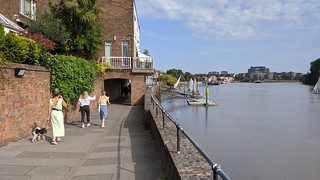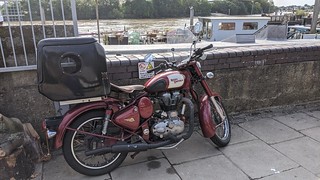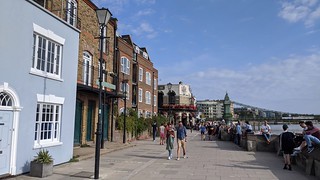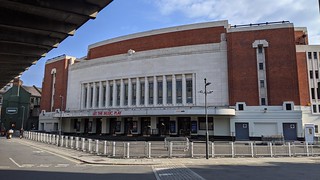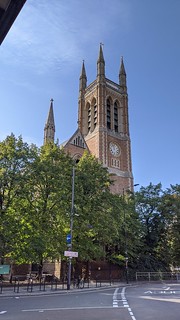Monday 7th September 2020
Lydney Harbour
Day three on holiday and I'm looking for local history. Nearby in Lydney the map shows an ancient monument, Lydney Harbour which as well as a harbour has a canal and disused railway. Out into the wet and windy morning I went.
 |
Lydney Harbour tidal basin
|
The harbour at Lydney wasn't quite what I'd imagine a harbour to look like (if I hadn't already checked the map) being long and narrow and looking more like a lock.
It lies at the end of a 1 mile canal and gives access to the tidal River Severn. The gates of the tidal basin shown here appear to be stuck open so that it is filling up with silt from the river. They're spending a couple of million on the site to upgrade the tourist facilities (hence the digger and wire fencing) so hopefully that will include fixing the gates. Parking is currently free though after the refurbishment who knows.
Between the tidal basin and the canal is a lock and the canal serves as a marina for small craft.
A bit of history: The canal opened in 1813 and the outer harbour was completed in 1821. Coal and iron ore from the Forest of Dean was shipped out, brought down by a tramway which was in 1868 converted to a broad gauge railway although in 1872 that was converted to standard gauge.
As can be seen from the early 20th century map below there were extensive sidings serving the harbour.
 |
Lydney Harbour former railway
|
Parts of the track bed can be seen and walked along and there are markers pointing out wrecks on the river shore and "sighting stones" core drilled through pointing at distant landmarks.
Also a circle of standing stones, not ancient but dating from the refurbishment of the harbour around 2006 - apparently it works as a compass, something I failed to notice at the time.
I walked along the track bed on the west side of the
 |
Lydney Harbour marina
|
inner harbour then crossed the swing bridge and back up the east side to the lock and harbour entrance.
There are a lot of boats moored here, I'm not sure if they can get out onto the Severn until the tide gate is repaired? The
Environment Agency page doesn't mention it.
The last coal was shipped from the harbour in 1960 but imported wood was still being brought in by barge from Avonmouth. In 1977 the harbour closed and began to fall into disrepair, scheduled as an ancient monument in the 1980s with the swing bridge Grade II listed the harbour re-opened after a two-year project of restoration and enhancement in 2005.
 |
Lydney Harbour lock
|
There are still a few old buildings around the lock and harbour and if you look closely on the west side the remains of the coal tip shown on the above map where coal was offloaded from the trains to the barges.
The old mortuary building was inaccessible due to the ongoing building works - I gather it's going to be made into public toilets which will be dead convenient. Sorry.
Crossing back over via the lock gates I went out to the rather windy harbour entrance where I could see up and down the Severn.
 |
Severn Bridges
|
On a clear day you'd get a really good view of the Severn road bridges downstream, this wasn't a clear day and with occasional showers as well but the bridges were just about visible anyway. The view of the Berkeley Nuclear Power Station on the far side of the river was much clearer.
A short but heavier shower sent me from my perch on a bollard on the harbour wall back to the car.
So Lydney Harbour was interesting with quite a bit to look out for, let's hope they don't spoil it.
Lydney Junction
I parked in the railway station car park so that I could walk into Lydney town centre, between the two
lies Lydney Junction station, the southern terminus of the
Dean Forest Railway. Crossing over the tracks at the level crossing this very shiny Brush Type 2 diesel locomotive was hard to miss. Newly overhauled I think.
I'd have liked to take a ride on the DFR but when I tried to book for the Wednesday trip discovered that it was not possible to book only one ticket. No doubt trying to maximise their income under COVID-19 restrictions which I can sort of understand during the busy summer period but mid week after the schools had (finally) returned? I doubt that the train was going to be full. I note that this restriction remains in place even now in mid October. Alienating potential customers could be a policy that comes back to bite them in the arse.
Lydney Town
I can tell you that the walk from Lydney railway station to the town centre isn't very interesting, apart from trying to get across the A48 without being mown down by traffic at the roundabout. That the River Lyd near the boating lake smells quite unpleasant, although that might be the treatment works, and that on this particular post-lockdown Monday a lot of Lydney was still shut. At least it was some exercise.








































